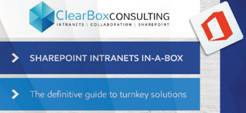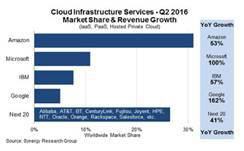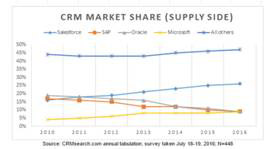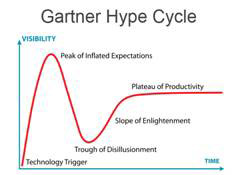In my previous blog article, I set the stage for this year’s predictions by looking at my predictions for 2015 (the first year I made predictions) and 2016. My track record definitely improved and I got 8 out of 10 predictions correct last year. I also declared that I would make 2017’s predictions much more measurable.
Here you go. I have carried over the two predictions that didn’t happen in 2016 (the ones in italics), and tried to make all of them more measurable, so you can hold my feet to the fire next year.
- The Intelligent Intranet will become a commonly-understood thing, and real
- Half of the intranet-in-a-box products will die
- A battle between Microsoft Teams and Facebook Workplace will hurt Slack and seriously wound Jive… but not kill Yammer
- Azure versus AWS versus Google Cloud – Azure will gain 10 points
- Data Sovereignty will become a factor in over half of enterprise IT projects
- Dynamics will gain 5 points on Salesforce
- Office Graph will finally cross the “Trough of Disillusionment”
- Tectonic Shift in the Web search market
- API Mashups will highlight search
- Hands-free Holographic information exploration will appear
The first three predictions are around Collaboration tools, particularly Intranets / Digital Workplaces. The next three relate to the “battle for the cloud” and Microsoft’s position. The last four are about Search, my home base.
Prediction 1: The Intelligent Intranet will become a commonly-understood thing, and real
The “Intelligent Intranet” is a term that seems like a Rorschach test right now. Even though several vendors have used this (including some back in the late ‘90s) and Microsoft is talking about the “Mobile and Intelligent Intranet”, there doesn’t seem to be any common understanding of what the term actually means.
I had a lot of fun in August interviewing people and asking them what they thought the Intelligent Intranet was – I got answers all over the map. (Check out my blog on the Intelligent Intranet and the videos from some of these interviews). I received 19 different answers from 27 people. One of my favorites: “I don’t know what the heck the Intelligent Intranet is, but I sure know what a dumb Intranet is – that’s what I’m using now!”
So, my prediction is that by the end of 2017, when I ask 10 people what the Intelligent Intranet means, at least 7 of them will say essentially the same thing. AND it will be “real”, which I’ll leave subjective. I will have personally used an Intranet which does noticeably more than you directly ask it, in a helpful and smart manner. Ultimately what matters if whether we have a new breed of better systems – from the user perspective – not so much what we call them. But I definitely see the rise of search-driven, tag-driven, personalized, and proactive Intranets, and I hope the market has a name for these because that will make it easier for people to get their minds around what’s possible with these systems.
Prediction 2: Half the internet-in-a-box products will die
 2016 saw an explosion of new products that built on SharePoint and/or Office 365 to provide a “ready to go” Intranet. Clearbox published a report covering 6 of these in January 2016; the 2nd edition came out in November and covered 26! This wasn’t just better coverage – it seemed like every System Integrator with a focus on SharePoint Intranets saw the opportunity and came out with a product within the same year. Some of these are more of a product than others.
2016 saw an explosion of new products that built on SharePoint and/or Office 365 to provide a “ready to go” Intranet. Clearbox published a report covering 6 of these in January 2016; the 2nd edition came out in November and covered 26! This wasn’t just better coverage – it seemed like every System Integrator with a focus on SharePoint Intranets saw the opportunity and came out with a product within the same year. Some of these are more of a product than others.
In May, Microsoft proclaimed an initiative to make Office 365 a really solid intranet out-of-the-box. And they made some significant strides during 2016 in that direction. It’s not there yet, but it’s pretty good – and there’s more to come from Microsoft.
It’s pretty clear that there is going to be some fallout here, so my prediction is pretty bold. By the end of the year, at least 13 vendors will pull out of this market. If you are starting a new Intranet Refresh project this year, using SharePoint and Office 365 is a safe bet – but you will need more than out-of-the-box capabilities, and it could be a confusing landscape.
Prediction 3: A battle between Microsoft Teams and Facebook Workplace will hurt Slack and seriously wound Jive … but not kill Yammer
Slack is a phenomenon: formed out of the ashes of a failed gaming startup, they are highly-hyped and growing insanely fast. Launched in February 2014 they reached 2.3 million daily active users (DAU) and 675,000 paid users by February 2016, and 4 million DAU/1.25 million paid users by the end of 2016. In April 2016 Slack raised $200M with a sky-high valuation: $3.8 Billion.
In October Facebook came out with Facebook Workplace; in November Microsoft came out with Teams. Both of these are hyped in the press as “Slack Killers”, fueled in part by Slack taking out a full-page ad in the New York Times on the day Microsoft announced Teams. 2017 is gearing up for a big battle – and I wouldn’t count Google out either. It’s also confusing that Microsoft has so many different (e.g. competing) collaboration tools, including Outlook Groups, Skype, Teams, and Yammer. Is Yammer dead?
I just did a fun podcast on the subject of chat-oriented collaboration tools and the brewing battle with Peter O’Kelly. Neither Facebook Workplace nor Microsoft Teams are direct reactions to Slack and their mission is not to “kill Slack.”
Facebook Workplace is definitely aiming to compete with Office 365. Interestingly, Facebook Workplace is actually complementary to Office 365 in many areas – Facebook themselves is using Office 365 for email, co-authoring, and content management, alongside Workplace, and there are parts of Office 365 used in Facebook’s service (this partnership was an interesting development in 2016).
Nevertheless, Slack is likely to feel some damage. And both Peter and I think the biggest collateral damage will actually be to players like Jive and IBM Connections/IBM Verse, which have neither the platform breadth nor the ‘consumer-grade experience’ going for them.
My prediction (with measurements) is that by the end of 2017:
- Facebook Workplace and Microsoft Teams will both be doing well and have at least 1 million paid accounts each
- Slack will slow down and not exceed 2.5 million paid accounts
- Yammer won’t die, it will continue to be folded into O365 and will have at least 4 million active users
- Jive will shrink and have lower revenue in 2017 versus 2016
Prediction 4: Azure versus AWS versus Google Cloud – Azure will gain 10 points
Another big market battle has been unfolding around cloud platforms. This is arguably the most important front Microsoft is fighting on. Microsoft typically is a “fast follower” – they watch market opportunities until someone else is getting real traction, and then jump in full force and try to outrun the pioneer (who has a head start). This worked great in the era when they were competing with IBM and Oracle, but it’s much harder against the likes of Amazon, Google, and Facebook.
 Yet Azure is gaining ground. By midyear, even though Microsoft was 20 points behind Amazon in market share, it was growing at twice the rate. The battle is palpable and fast-paced: when AWS introduces a new service or reduces prices, Azure does something very similar within a few weeks, and vice versa. It’s like the two competing gas stations in my neighborhood, which are across the street from each other and move their highly visible prices nearly in lockstep.
Yet Azure is gaining ground. By midyear, even though Microsoft was 20 points behind Amazon in market share, it was growing at twice the rate. The battle is palpable and fast-paced: when AWS introduces a new service or reduces prices, Azure does something very similar within a few weeks, and vice versa. It’s like the two competing gas stations in my neighborhood, which are across the street from each other and move their highly visible prices nearly in lockstep.
At Microsoft Ignite in November, cloud security, GPU/FPGA hardware acceleration, hybrid cloud tooling, and new data centers were front and center – including separate entities set up specifically for the complex German and Chinese markets. These are areas where Microsoft has an edge.
It’s still not obvious how this will play out. Amazon is an amazing organization and AWS has a very strong position. Plus, Google is coming on strong, and growing even faster than Microsoft in this market.
My prediction is that Azure will gain 10 points in worldwide market share during 2017. This will mostly be at Amazon’s expense, though some might be taken from IBM, Rackspace, AT&T, or others.
Prediction 5: Data Sovereignty will become a factor in over half of enterprise IT projects
Over the last 18 months, data sovereignty laws have become the cloud’s biggest threat. New government regulations from various countries are presenting new concerns for companies with operations in multiple countries. For example, the United States-European Union “Safe Harbor” agreement was struck down, and Russia introduced a localization law mandating that personal data on Russian citizens must be stored in databases physically located within the country itself.
I was on a panel in December on “the future direction of SharePoint” and happened to mention this trend, in the context of Microsoft adding new local data centers in many countries including Germany and China. What surprised me was that this issue took over the panel session and people kept asking more and more questions about it. This is becoming a huge concern that keeps the Chief Compliance Officers of large global companies awake at night.
My prediction is that this headache will spread rapidly in 2017, touching companies that aren’t cross-border and projects that have been blissfully immune from compliance concerns to date. To make it measureable, I’ll define it as over 50% of the new IT projects started in the second half of 2017 at companies with over $1B revenue will have undergone a detailed review specifically for data sovereignty concerns.
I hope that this prediction doesn’t come to pass, even though it may create opportunities for companies like BA Insight that have solutions for this problem. It would add cost, time, and friction to everything, and might take a long time to settle down. I talked to a high level executive at Microsoft about this who said “the laws will change to relax this situation.” My prediction (and fear) is counter to that; countries seem to be becoming more isolationist/protectionist politically and I fear we’ll see new, more onerous laws before things get better.
Whichever way this plays out, it will have an impact on the battle for the cloud. On every battlefront– Azure, Office 365, Dynamics 365 – Microsoft aims to attract large enterprises as well as small businesses, and they are paying serious attention to the data sovereignty issue.
Prediction 6: Dynamics will gain 5 points on Salesforce
 Microsoft has tried several times over the last decade to accelerate traction in the CRM market, where Salesforce is a considerable foe. In 2016 there were two big developments that I think might finally tip the scales: the introduction of Dynamics 365 and the acquisition of LinkedIn.
Microsoft has tried several times over the last decade to accelerate traction in the CRM market, where Salesforce is a considerable foe. In 2016 there were two big developments that I think might finally tip the scales: the introduction of Dynamics 365 and the acquisition of LinkedIn.
Lest you think my prediction is a layup, here’s a little CRM market data. Salesforce has about three times the market share of the three vendors tied for 2nd place (SAP, Oracle, and Microsoft). Although it’s pretty clear Microsoft will beat SAP and Oracle, Dynamics has actually continued to lose ground relative to Salesforce. Salesforce is also getting stickier – their retention rates are very high and growing, and 75% of their top 200 customers are using 4+ clouds from Salesforce, versus only 20% just one year ago.
Plus – CRM vendors other than the big 4 are gaining ground. There are a lot of specialists and innovative startups in this space, and the market is becoming less top-heavy. For Microsoft to gain ground here, they have to have all the cylinders working perfectly in their complicated engine.
My prediction: Dynamics will gain 5 points on Salesforce, means that I predict Microsoft’s growth will come out of Salesforce’s hide, not just the weaker players. End of 2016 numbers aren’t published yet, but let’s say Salesforce has 25% and Microsoft 10% now. That’s a 15-point difference; at the end of 2017 I predict that is cut down to a 10-point difference.
Prediction 7: The Office Graph will finally cross the “Trough of Disillusionment”
Microsoft introduced the Office Graph in March 2014 (initially as “project Oslo”, and it got a lot of attention and hype). Personally I love it, and not just because it is built on search technology by folks I know in Norway. I use Delve, the first (and primary) application using the Office Graph, every day to see what others are doing and to find things through the connection to people. But it seems like many people don’t really know what to do with Delve. Adoption is definitely growing, but the question is whether this will really become mainstream, and when.
 The “Trough of Disillusionment” is a term from the Gartner Hype Cycle. I definitely think the Office Graph is past the hype and inflated expectations, and into the Trough. I predict it will get on the “slope of enlightenment”, or even further, this year. I’ve been bullish about this and lost 10% on it for the last 2 years, but I still think it will get there and won’t be stuck (or die on the vine). Now many other parts of Office365 use the Office graph, so it’s not just about Delve adoption.
The “Trough of Disillusionment” is a term from the Gartner Hype Cycle. I definitely think the Office Graph is past the hype and inflated expectations, and into the Trough. I predict it will get on the “slope of enlightenment”, or even further, this year. I’ve been bullish about this and lost 10% on it for the last 2 years, but I still think it will get there and won’t be stuck (or die on the vine). Now many other parts of Office365 use the Office graph, so it’s not just about Delve adoption.
To make it measurable, I predict that Delve MAU (monthly active users) will exceed 20% by the end of the year. In other words, one in five O365 users will use Delve regularly; if you assume there’ll be at least 80 Million genuine commercial users (taking Microsoft numbers with a pound of salt), one in five means at least 16 Million regular Delve users. I think that counts as mainstream.
Prediction 8: Tectonic Shift in the Web Search market
Google has been uber-dominant in web search for so long that we take it as a given. But I think that we’ll see a noticeable shift this year. Tectonic plates are going to move.
This one is interesting to me primarily because consumer search sets the expectation for enterprise search. A big shift in the web search space will bring in some innovation and changes inside the firewall, too.
There’s various ways this market is tracked – by % of users, % of searches, or % of ad revenue, usually broken out by geography and by desktop versus mobile use. For example, Microsoft made a big deal out of Bing crossing 20% market share in 2016 – based on a comScore report on desktop percentage of searches. But I think this is a very slanted view – and it is clearly driven by Windows 10. People generally know how to set their browser search, but desktop search and Cortana are now wired to Bing and run a lot of searches for you in the background (which doesn’t drive any advertising, by the way).
In the spirit of accountability, I’ll refer to the netmarket reports, which anybody can see (plus I think user share is a better view of what’s going on). Right now they show Google with 78% desktop search market share (with Bing at 8%). For Mobile/Tablet search Google has essentially the whole market, with 94% (versus 1% for Bing).
I haven’t seen anybody else make any prediction or observations like this. I’m going out on a limb here. Here’s a couple of semi-random things influencing my intuition that there’ll be a big shift:
- Ad-blocking and anti-ad-blockers are showing up, which could muck with the enormous ad revenue stream that drives Google
- Bing is finally making money for Microsoft. Where it was losing a billion dollars per quarter 3 years ago, it is now making a $1B/quarter in profit
- The Microsoft/Yahoo algorithmic search agreement was renegotiated in 2015, and Yahoo’s acquisition by Verizon is expected to be complete in 2017.
- Apple’s Siri, which drives a lot of traffic, has started branching out. Apple includes Bing and Wolfram Apha in its set of back-end services.
- China’s Baidu and Russia’s Yandex, the “Googles” of their home countries, have kept and actually grown dominant market share locally and are both eyeing the global market
- Facebook, not considered part of this market at all, has quietly amassed huge search volume. They are reportedly at 30 Billion searches/month. For comparison, Google’s at 165B/month, Bing’s at 24B/month, YouTube’s at 1B/month, and LinkedIn’s around 0.1B/month.
I don’t actually have a clue about HOW things will shift. It’s one thing to sense that we’re on a fault line and another to predict exactly when and where the earthquake will be, and what magnitude. I’ll leave this one subjective and simply predict that the shape of these graphs will look different by the end of the year, with at least one of the pie slices moving by 5% or more.
Prediction 9: API Mashups will highlight Search
API Mashups have been around for about a decade and used in enterprise applications since about 2009. They combine multiple APIs in creative ways, and are used for lots of data aggregation and visualization applications. Gartner has predicted that API mashups will be the successor to portals. I have seen some insanely complex things built very quickly with this approach.
The hype around API Mashups probably peaked 3-4 years ago, and you hear the term a little less these days, though there are still more and more mashup contests and frameworks. Microsoft Flow, introduced in early 2016 is an easy-to-use mashup tool, modeled in many ways after the point-and-click web mashup startup ifttt (“if this then that”) that was founded in 2011.
Given that search technology is SO good at providing quick and easy data aggregation and access, I’ve expected that search would play a really strong role in these mashups. And under the hood, it does. Get into the guts of any twitter mashup like Portwiture, or any Google mashup, and you’ll find the search APIs are used a lot. But there hasn’t been much of a focus or spotlight on search or findability in enterprise mashups. My prediction is that this spotlight will show up this year.
I counted this prediction as a miss last year, based simply on not having noticed any prominent mashups with “search” in the name or 1-line description. I’m carrying this over for 2017 but I’ll make it more measurable: One of the winners of a major mashup contest will highlight search (using words like search, findability, discovery, explanation). Major means something like the Amazon Alexa Mashup contest or the IBM Watson Mashup contest – and NOT something like the University of Nebraska Mashup competition (nothing against Nebraska, just an example).
Prediction 10: Hands-free Holographic Information Exploration will appear
 Augmented Reality was a big buzz in 2016. There have been working Virtual Reality (VR) systems since 1968 and working Augmented Reality (AR) systems since 1992, and Google Glass has had a tough road – after 5 years of availability to developers, it is still in “experimental status” and even the newest Project Glass Model is exorbitantly priced at $1,500.
Augmented Reality was a big buzz in 2016. There have been working Virtual Reality (VR) systems since 1968 and working Augmented Reality (AR) systems since 1992, and Google Glass has had a tough road – after 5 years of availability to developers, it is still in “experimental status” and even the newest Project Glass Model is exorbitantly priced at $1,500.
But it seems like AR’s time has finally come. In March Microsoft released HoloLens (developer edition) and 2016 Oculus Rift also started shipping. Both of these devices have showcased some VERY cool applications. For example, at Microsoft Ignite in November, GE showed aircraft engine repair training and field troubleshooting using AR, and Lowes showed an interactive kitchen-design application.
My prediction: there will be a system working in production that allows hands-free exploration of data in 3D augmented reality by the end of 2017.
Here’s an example scenario: lab scientists who work in cleanrooms have problems using computers. Obviously, hands-free means voice input. However, straight out-of-the-box Cortana or Siri is incredibly clunky for information exploration, some additions need to happen to make this user friendly. Plus, you need visual output – a voice describing documents or numbers might work for question answering ala Echo, but certainly not for exploration of complex data. A HoloLens/Kinect/Cortana setup could allow voice input, gestural exploration, and overlaid 3D visual output. That’s a search-driven application straight out of Minority Report.
It’s not at all obvious this will reach production this year – it needs HoloLens to get beyond developers-only status at a reasonable price point, and avoid the kind of issues Microsoft had with Kinect. (Alternately, Google Glass could actually release, and/or Oculus Rift could take on AR as well as VR). THEN the overall application has to work well enough that it’s not just a sexy demo but a real, useful, user-ready system.
What do YOU think?
I put special attention into making these predictions more measurable, and hope I’ve done so without detracting from them. The real purpose of these predictions is to provoke thoughts, share some useful insights, and perhaps expose you to some things you didn’t know about before.
I’d love your feedback – and your own predictions if you care to make them. Let’s see how these unfold through 2017!


